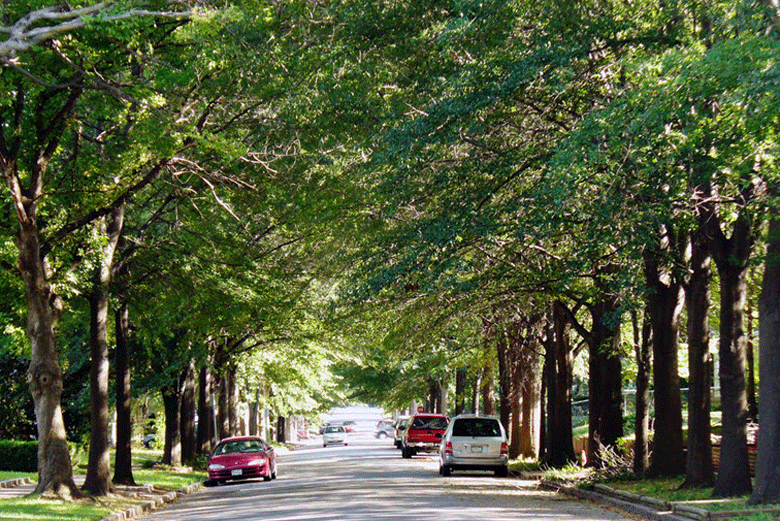There is no shortage of appropriate responses to climate change and global pollution—walking instead of driving, insulating your house, trading your leaf blower in for a rake. You can doubtless think of many more yourself.
But planting a shade tree along your street, preferably in your own front yard or, if there isn’t room or you don’t have a front yard, as part of a neighborhood or town campaign to get trees along nearby streets is a great gesture toward planetary salvation that’s too often ignored.
The benefits of trees close to homes are multiple. “Street trees,” those planted in public rights of way, absorb as much carbon as other trees—what’s known as mitigation in the language of climate conferences. But the benefits don’t stop there. Such trees also cancel out some of the blistering radiant heating effects of pavement and help cool sidewalks, houses and other buildings that are beneath them, an “adaptation” measure that will become increasingly important as the planet warms in the years ahead.
The cooling effect is as great as 20-45 degrees Fahrenheit, according to U.S. government studies, and major energy savings can result from reduced use of air conditioning.
Such trees also cancel out some of the blistering radiant heating effects of pavement and help cool sidewalks…
Just as important, trees are beautiful and help bring a sense of calm and well-being to the increasingly unstable and agitated worlds we inhabit. Indeed, this may be the most important thing of all. Trees once lined Elm streets in towns across America. They mostly died from Dutch Elm disease in the decades after World War II.
Other trees were planted in their place, not initially as large and elegant as the ones they replaced, of course, but many have grown to be very beautiful in their own non-elm-like ways. Those trees are now themselves aging and, sadly, many either have diseases of their own, are stressed by changing climatic conditions, or are simply viewed as being “in the way” by the owners or by many towns and electric utilities.
Many of these could and should be saved. More than 20 years ago, Camden, where I live, adopted an ordinance requiring that anyone wanting to cut down or even prune a “shade tree” in the public right of way along streets and roads must first get the consent of the town’s tree warden.
Many states, cities, and towns in this country have similar laws designed to help save street trees and shade trees more generally. More of our towns in Midcoast Maine should have such laws or if, like Camden, they already have legislation of this type, should consider whether a stronger law and stronger enforcement might be appropriate.
If the trees are terminally ill, though, they have to be cut. And many have already been downed. What is needed in their place are not small ornamental trees. Those are lovely and can grace our lives from further back in yards and other places where we want sunshine.
But not along sidewalks, where we want to encourage more walking and biking. There we need large, leafy shade trees that will cool our streets for decades to come.
Maine is relatively cool by U.S. standards, but even so, those who have walked around downtowns in summer will know how welcome the shade and graceful beauty provided by a canopy of leaves high above you can be.
Sarah Miller is a semi-retired international energy and business journalist and editor who lives in Camden. This column first appeared as a blog on the Penobscot Bay Pilot website.





